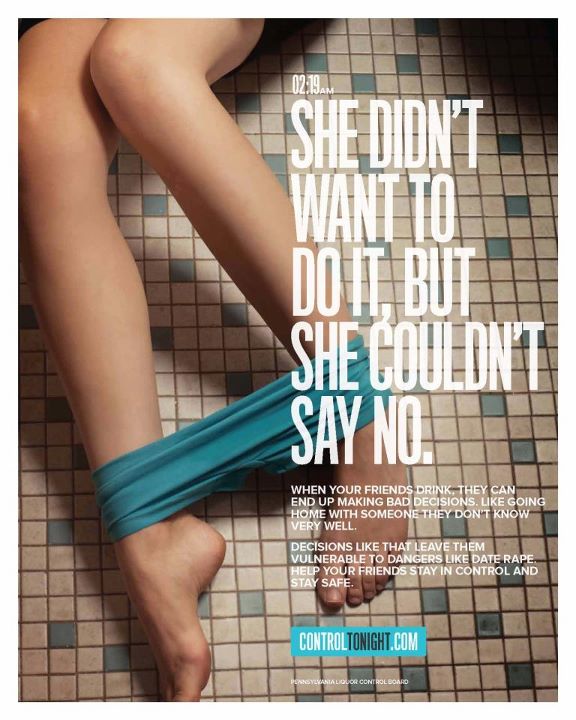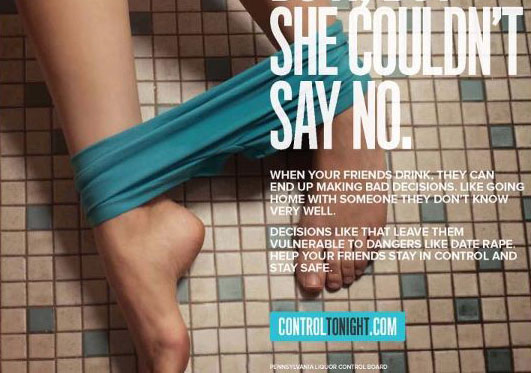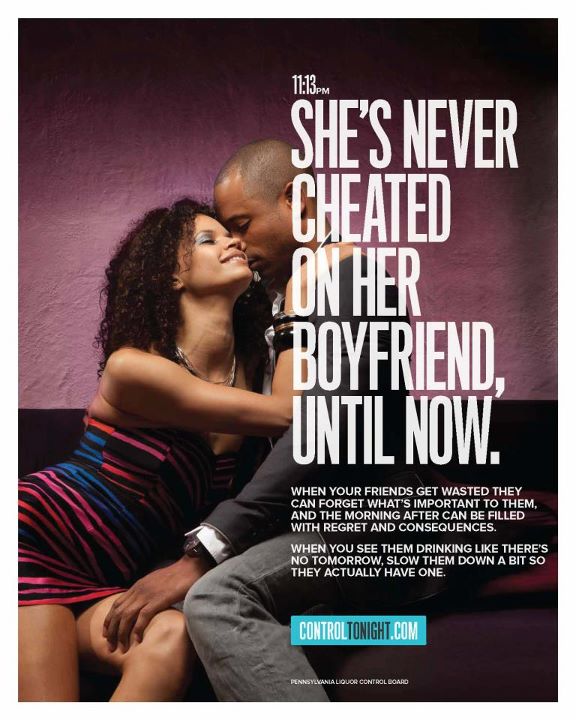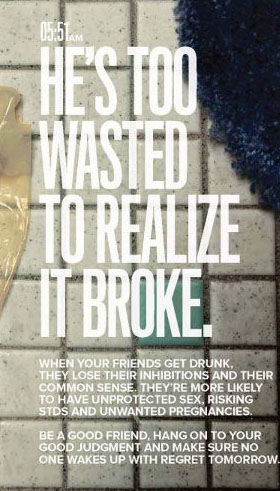

|
Figure 1 is a shocking image that displays a pair of female legs from the knees down, posed dejectedly with a pair of panties stretched between the two ankles. This is a synecdochical image that reduces a female to nothing more than a pair of feminine legs and stretched panties. These legs are positioned on a dirty tile floor, which can be assumed to be a bathroom, and are inhabiting a wholly solitary space. The legs are being held together at the knees, suggesting shame and vulnerability. Viewers can assume when looking at the woman's positioning that they are looking at the aftereffects of some kind of unwelcome violation. |
|
A large white set of text is positioned directly to the right of the legs
like a warning sign that reads, "She didn't want to do it, but she couldn't say
no." Beneath this larger text is a set of smaller text: "When your friends
drink, they can end up making bad decisions, like going home with someone they
don't know very well. Decisions like that leave them vulnerable to dangers like
date rape. Help your friends stay in control and stay safe."
The placement of the larger text as it starts at the top of the page and ends right beneath the pair of underwear takes the viewer's eyes down slowly through the scene. As the viewer reads each word, there is a new part of the scene to be experienced directly to the left. The large text ends in a line of text that could stand alone in this advertisement: "say no." The text also has underlying rhetorical enthymemes to it, or meanings/messages that are communicated without the explicit use of the words that normally communicate them. For example, the advertisement can be better read as this: "She didn't want to do it (SEX), but she couldn't say no (because she was DRUNK), and who got her drunk? She did. Where were her friends (you)? The current situation is both yours and her fault. |

|
The scene of the advertisement makes itself very clear as a nondescript
bathroom. The lack of adornments in the space (such as decoration or
knickknacks) allows the bathroom to be seen by the viewer as any bathroom in
the world. The majority of bathrooms have tile floors and one can assume that
the shadow in the upper right hand corner is from the toilet inhabiting the
space. That this bathroom could be any bathroom in the world operates to
further draw the viewer in and place themselves within the advertisement.
The tile floor also serves the purpose of reminding the reader that this environment is cold, hard and uncomfortable. Any sexual act to have taken place here would have been impersonal and quick, which according to dominant cultural ideology, is not how sex is supposed to be.The woman pictured here is caucasian and acts as a signifier of the target audience of the advertisement. This ad is aiming to interpolate young, caucasian women to warn them against the potential dangers of their actions, namely, the consumption of alcohol. |

|
Figure 2 is an initially less shocking image than figure one, but the
message is essentially the same. An provacatively dressed young woman, whom
the viewer can assume to be intoxicated, is supporting herself against a
seemingly sober man. As Capezza & Arriaga note, "Victims of rape are blamed
more or seen as more responsible for, and deserving of, the rape when they
are seductively-dressed rather than plainly dressed" (840). The two are alone in
the image, implying that the situation is intimate and involves only them. Over the body of the man is
another large white text warning that reads, "She's never cheated on her
boyfriend, until now." Beneath this lies the following subtext: "When your
friends get wasted they can forget what's important to them, and the morning
after can be filled with regret and consequences. When you see them drinking
like there's no tomorrow, slow them down a bit so they actually have one."
This advertisement once again interpolates the viewer as a potential friend
of someone in the situation being depicted. Not only can that viewer see
themselves as the woman, they have the point of view to also see themselves
as someone responsible for her.
The woman in the advertisement serves as a physical model for inebriation
and its effects. She has a overly-relaxed face, crumpled, disheveled clothing,
and seems to literally be holding on the the man next to her to keep herself
from sliding straight to the floor. Her legs are slightly parted, giving the
viewer the idea that she has the desire to have sex with the man. Her overall
appearance gives the viewer the notion that due to being drunk, she no longer
cares about what she looks like. This reinforces the idea that women should
care about what they look like at all times and always try to look somewhat
respectable and refined. The woman's posture and presence here is a direct
reference to this normative value and her deviation from that norm is being
blamed on her choice to drink alcohol. Also notable in this image is the woman's
race. As an African American, the woman carries certain cultural connotations in this
seemingly sexual situation. According to George & Martinez, "commonplace stereotypes
and myths portray Blacks as excessively sexual compared to whites...black women
have been stereoptyped as being more sensuous, permissive, and promiscuous than
white women and as having less need or desire for foreplay...they mythically are
'unrapeable' because of their wanton, chronically promiscuous nature" (110).
|

|

|
Figure 3 distinguishes itself from the other two advertisements in that
its goal is to speak to male viewers. The image of a lone broken condom on a
barren bathroom floor and a small narrative about how it arrived there
present this situation as one that men who consume alcohol would potentially
have to contend with. The absence of the other sexual participant in physical
or semantic form creates a blame paradigm that involves only the drunken male
participant and his friend(s). The scene's most salient and eye-catching
component is the elongated, broken, and used condom that lies ominously on
the grimy bathroom floor. It is blatantly broken, so that the viewer may
easily see how the effects of alcohol can alter one's state of mind in ways
that render normal human senses inoperable.
Beside the broken condom is yet another large block of text resembling a warning: "He's too wasted to realize it broke." Beneath this it reads, "When your friends get drunk, they lose their inhibitions and their common sense. They're more likely to have unprotected sex, risking STDs and unwanted pregnancies. Be a good friend. Hang on to your good judgement and make sure no one wakes up with regret tomorrow." Above this text is the time on which this situation occurred, 5:51AM. |

|